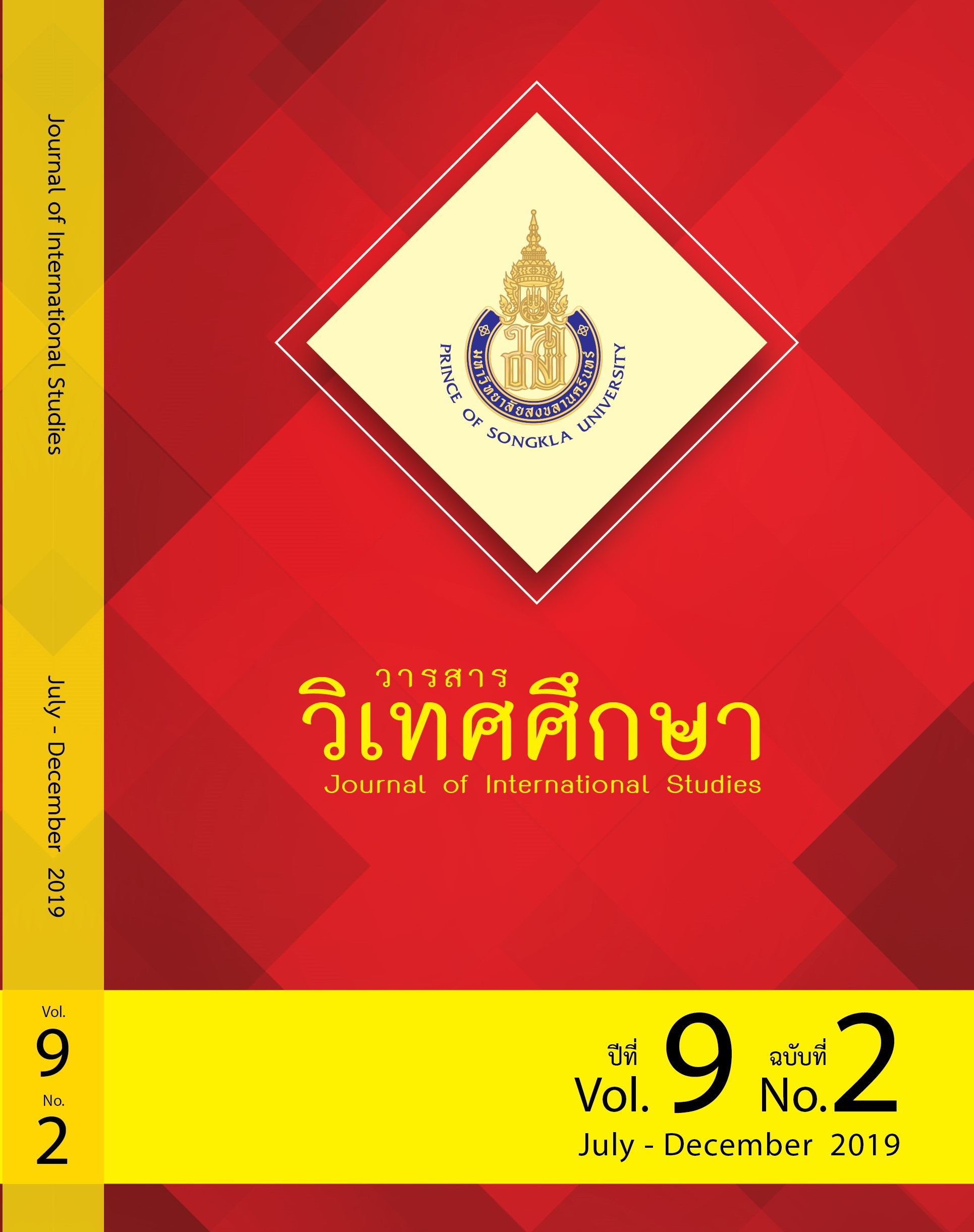Importance-performance analysis (IPA) of Digital Information Quality: The international tourists’ perspective
Main Article Content
Abstract
Nowadays digital information is the most common source of information used for tourists to gather information about destination. In a highly competitive tourism market, the quality of information provided for tourists is essential. understanding the importance and satisfaction of information quality provided by destination in the tourists’ point of view is necessary. Therefore, the objective of this study are 1) to identify the strengths and weaknesses of digital information quality of Thailand by importance-performance analysis (IPA) 2) to investigate the gap between ‘importance digital information quality and performance. From total 17 attributes, 8 of them are located in Quadrant 1 “Keep up the Good Work”. There is no attribute located in Quadrant 2 “Concentrate Here. There are 8 attributes in Quadrant 3 “Low Priority”, and only 1 attribute in Quadrant 4“Possible Overkill”. This study is beneficial because the performance and satisfaction of digital information quality of Thailand can be identified for further improvement.
Article Details
Statements and opinions expressed in articles herein are those of the authors and do not necessarily reflect the position of the editors or publisher.
Article, information, text, image, etc. which are published in Journal of International Studies, belong to Journal of International Studies. If anybody or any organization would like to use part or whole of them, they must receive written permission from Journal of International Studies before usage.
References
Bell, R. (2016). A critical evaluation of information sources used in the tourist destination decision making process (Doctoral Dissertation). University of Salford, Manchester.
Bizirgianni, I., &Dionysopoulou, P. (2013). The influence of tourist trends of youth tourism through social media (SM) & information and communication Technologies (ICTs). Procedia - Social And Behavioral Sciences, 73, 652-660. doi: 10.1016/j.sbspro.2013.02.102
Boley, B., McGehee, N., & Tom Hammett, A. (2017). Importance-performance analysis (IPA) of sustainable tourism initiatives: The resident perspective. Tourism Management, 58, 66-77. doi: 10.1016/j.tourman.2016.10.002
Chung, N., Lee, H., Lee, S., & Koo, C. (2015). The influence of tourism website on tourists & behavior to determine destination selection: A case study of creative economy in Korea. Technological Forecasting and Social Change, 96, 130-143. http://dx.doi.org/10.1016/j.techfore.2015.03.004
Daphet, S. (2016). Applying importance-performance analysis to identify competitive travel attributes: An application to regional destination image in Thailand. Journal of Community Development Research (Humanities and Social Sciences), 10.
DeLone, W., & McLean, E. (2003). The DeLone and McLean model of information systems success: A ten-year update. Journal of Management Information Systems, 19(4), 9-30. doi: 10.1080/07421222.2003.11045748
Deng, J., &Pierskalla, C. (2018). Linking importance–performance analysis, satisfaction, and loyalty: A study of Savannah, GA. Sustainability, MDPI, Open Access Journal, 10(3), 704. doi: 10.3390/su10030704
Djeri, L., Stamenković, P., Blešić, I., Milićević, S., &Ivkov, M. (2018). An importance-performance analysis of destination competitiveness factors: case of Jablanica district in Serbia. Economic Research-EkonomskaIstraživanja, 31(1), 811-826. doi: 10.1080/1331677x.2018.1456351
Dwyer, L., Cvelbar, L., Edwards, D., &Mihalic, T. (2012). Fashioning a destination tourism future: The case of Slovenia. Tourism Management, 33(2), 305-316. doi: 10.1016/j.tourman.2011.03.010
Fotis, J., Buhalis, D., &Rossides, N. (2012). Social media impact on holiday travel planning. International Journal Of Online Marketing, 1(4), 1-19. doi: 10.4018/ijom.2011100101
Grewal, D., Gotlieb, J., &Marmorstein, H. (1994). The moderating effects of message framing and source credibility on the price-perceived risk relationship. Journal of Consumer Research, 21(1), 145. doi: 10.1086/209388
Gronflaten, O. (2005). Sources and channels of tourism information: An exploratory study of travellers' Choice of Information Search Strategies (Doctoral Dissertation). Griffith University, Brisbane.
Gros, C. (2012). The influence of social media on consumers during their purchase decision-making process and the implications for marketers (Master’s Thesis). Dublin Business School, Leinster.
Heung, V. (2003). Internet usage by international travellers: reasons and barriers. International Journal of Contemporary Hospitality Management, 15(7), 370-378. doi: 10.1108/09596110310496015
Huang, C., Wang, Y., Wu, T., & Wang, P. (2013). An empirical analysis of the antecedents and performance consequences of using the moodle platform. International Journal Of Information And Education Technology, 217-221. doi: 10.7763/ijiet.2013.v3.267
Lee, Y., Strong, D., Kahn, B., & Wang, R. (2002). AIMQ: A methodology for information quality assessment. Information & Management, 40(2), 133-146. doi: 10.1016/s0378-7206(02)00043-5
Leung, D., Law, R., Van Hoof, H., &Buhalis, D. (2013). Social media in tourism and hospitality: A literature review. Journal of travel & tourism marketing, 30(1-2), 3-22
Marchiori, E., &Cantoni, L. (2015). The role of prior experience in the perception of a tourism destination in user-generated content. Journal of Destination Marketing & Management, 4(3), 194-201. http://dx.doi.org/10.1016/j.jdmm.2015.06.001
Martilla, J., & James, J. (1977). Importance-performance analysis. Journal of Marketing, 41(1), 77. doi: 10.2307/1250495
Meslat, N. (2018). Impact of social media on customers’ purchase decision (Undergraduate). Turku University of Applied Science, Turku.
No, E., & Kim, J. (2015). Comparing the attributes of online tourism information sources. Computers In Human Behavior, 50, 564-575. doi: 10.1016/j.chb.2015.02.063
Oh, H. (2001). Revisiting importance–performance analysis. Tourism Management, 22(6), 617-627. doi: 10.1016/s0261-5177(01)00036-x
Poon, S., & Joseph, M. (2001). A preliminary study of product nature and electronic commerce. Marketing Intelligence & Planning, 19(7), 493-500. doi: 10.1108/02634500110408295
PhoCusWrightInc (2012). Information sources for destination decision. [image] Available at: http://www.greatwalladventure.com/ChinaTravelGuide/201303-China-Tours.htm [Accessed 17 Nov. 2018].
Sadovykh, V., Sundaram, D., &Piramuthu, S. (2015). Do online social networks support decision-making?. Decision Support Systems, 70, 15-30. doi: 10.1016/j.dss.2014.11.011
Sörensson, A., & von Friedrichs, Y. (2013). An importance–performance analysis of sustainable tourism: A comparison between international and national tourists. Journal Of Destination Marketing & Management, 2(1), 14-21. doi: 10.1016/j.jdmm.2012.11.002
Värlander, S. (2007). Online information quality in experiential consumption: An exploratory study. Journal of Retailing and Consumer Services, 14(5), 328-338. doi: 10.1016/j.jretconser.2006.12.002
Wang, R., & Strong, D. (1996). Beyond accuracy: What data quality means to data consumers. Journal Of Management Information Systems, 12(4), 5-33. doi: 10.1080/07421222.1996.11518099
Xiang, Z., Wang, D., O’Leary, J., & Fesenmaier, D. (2014). Adapting to the Internet. Journal of Travel Research, 54(4), 511-527. doi: 10.1177/0047287514522883
Yang, L., Chou, T., & Ding, J. (2011). Using the importance-performance analysis (IPA) approach to measure the service quality of mobile application stores in Taiwan. African Journal Of Business Management, 05(1993-8233), 4824-4834. doi: 10.5897/AJBM10.1163


